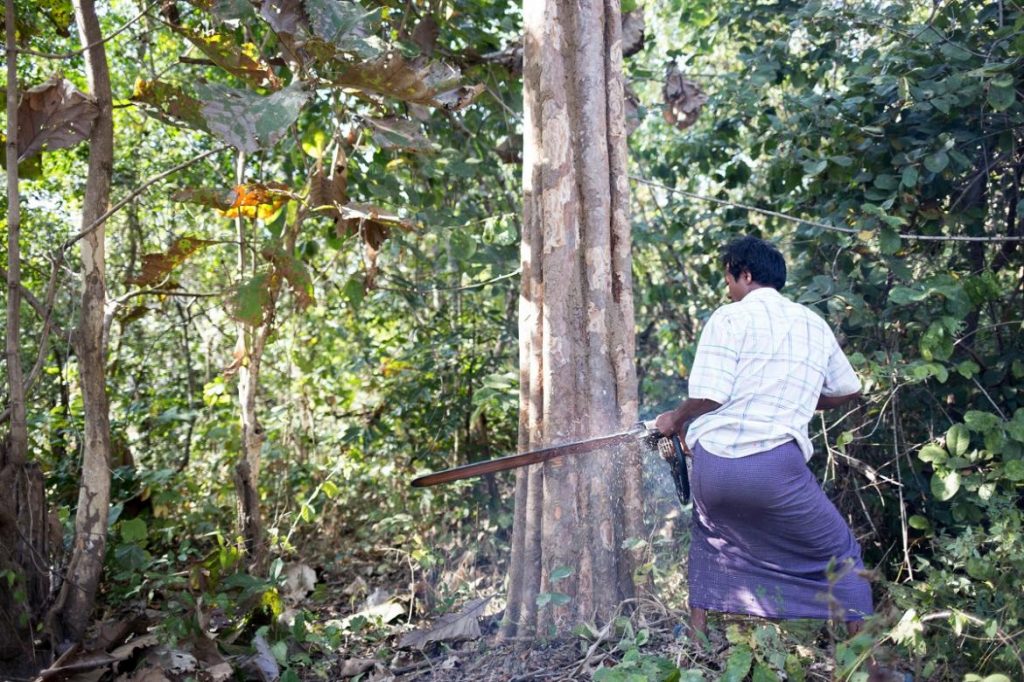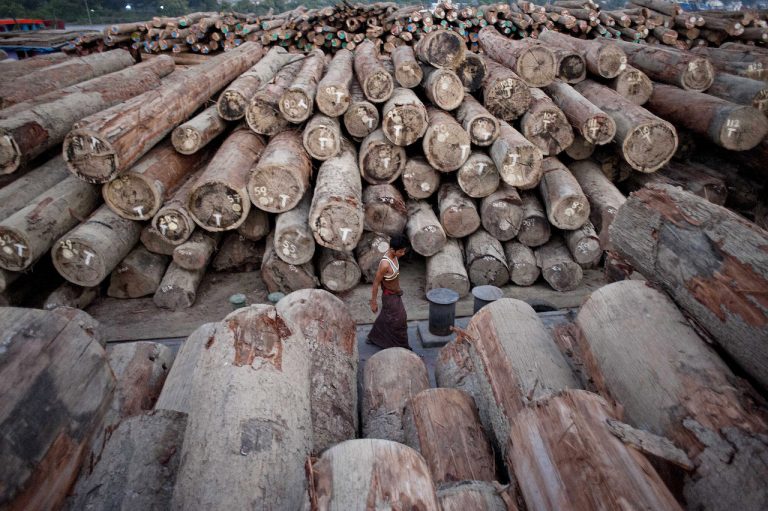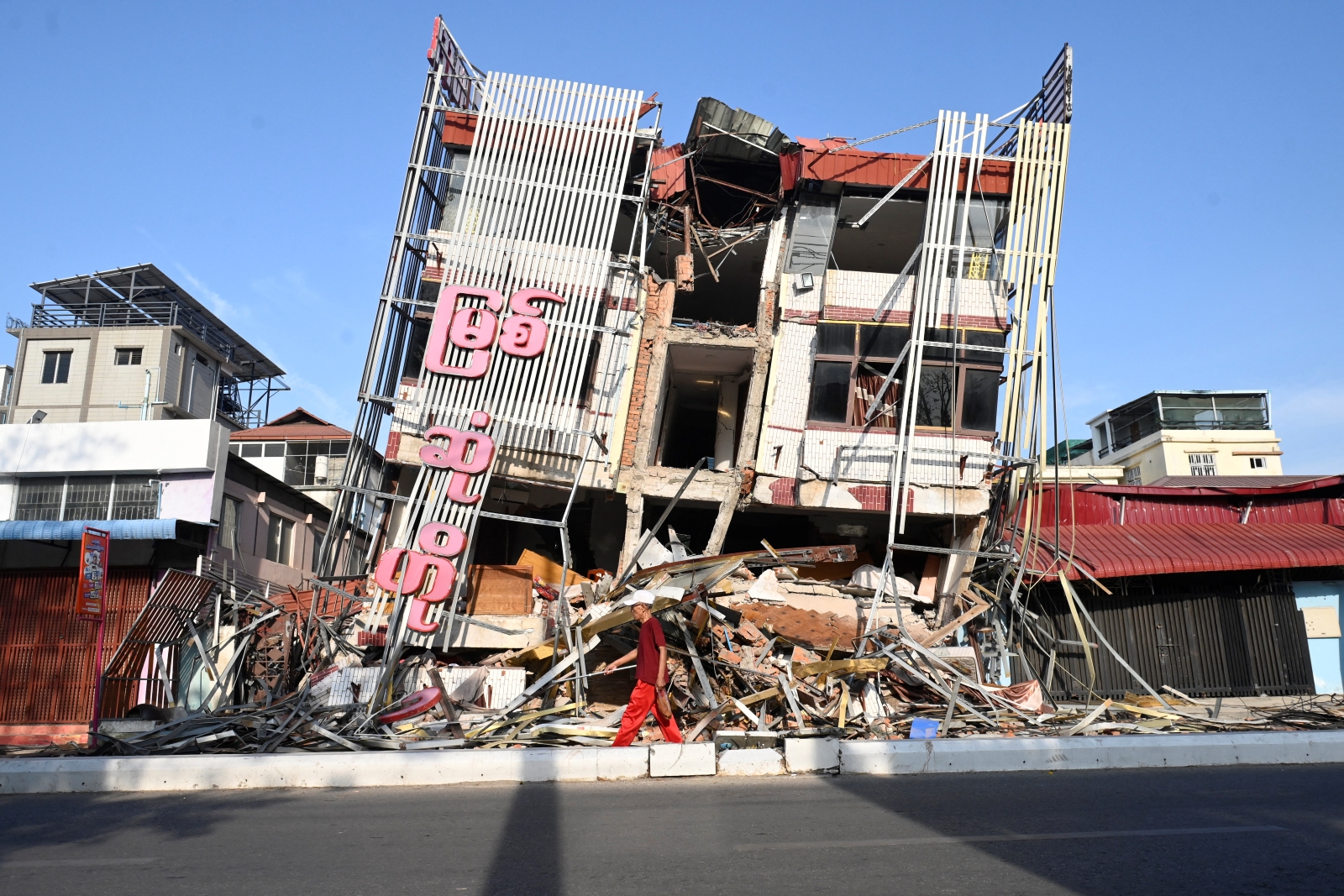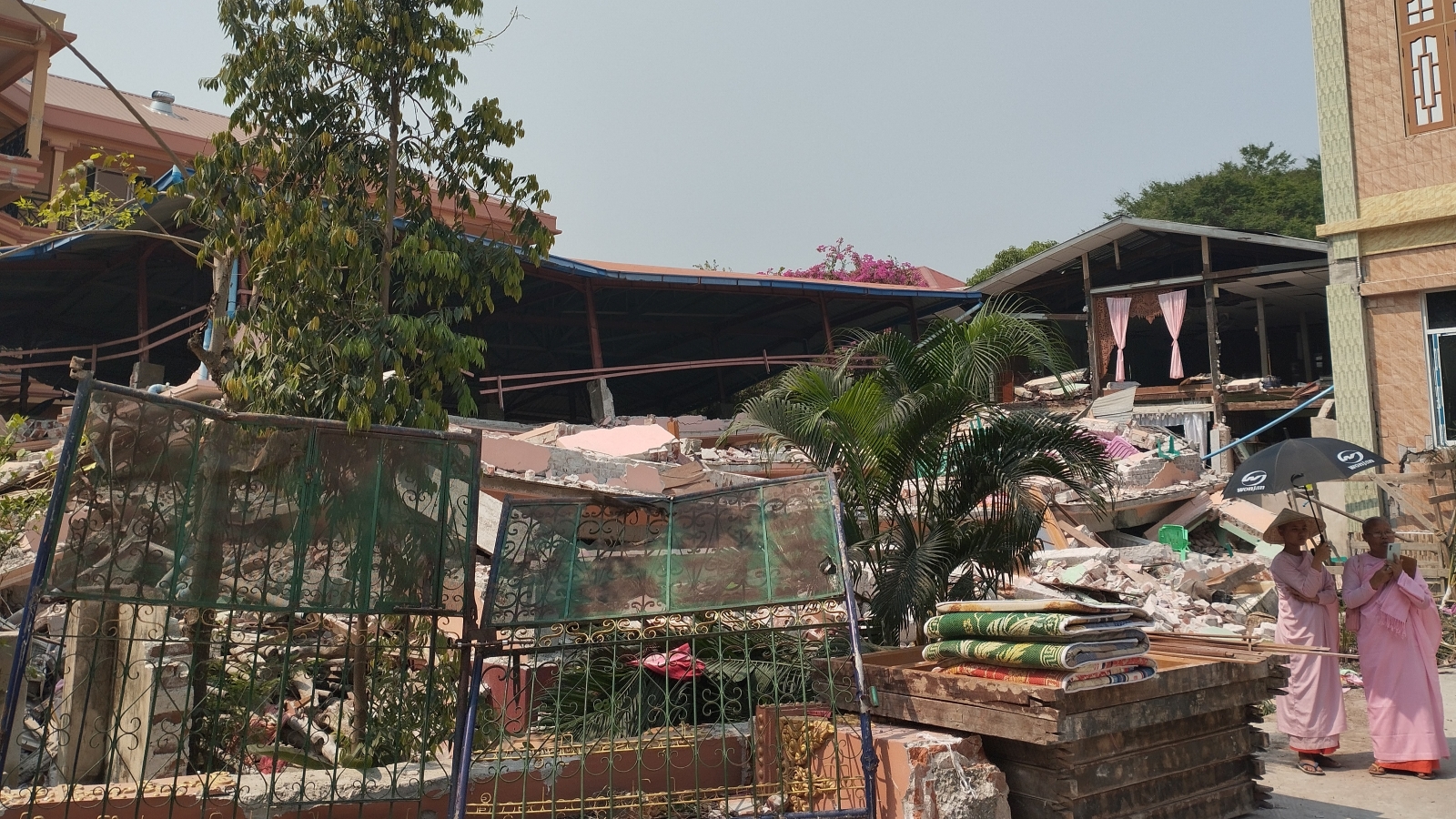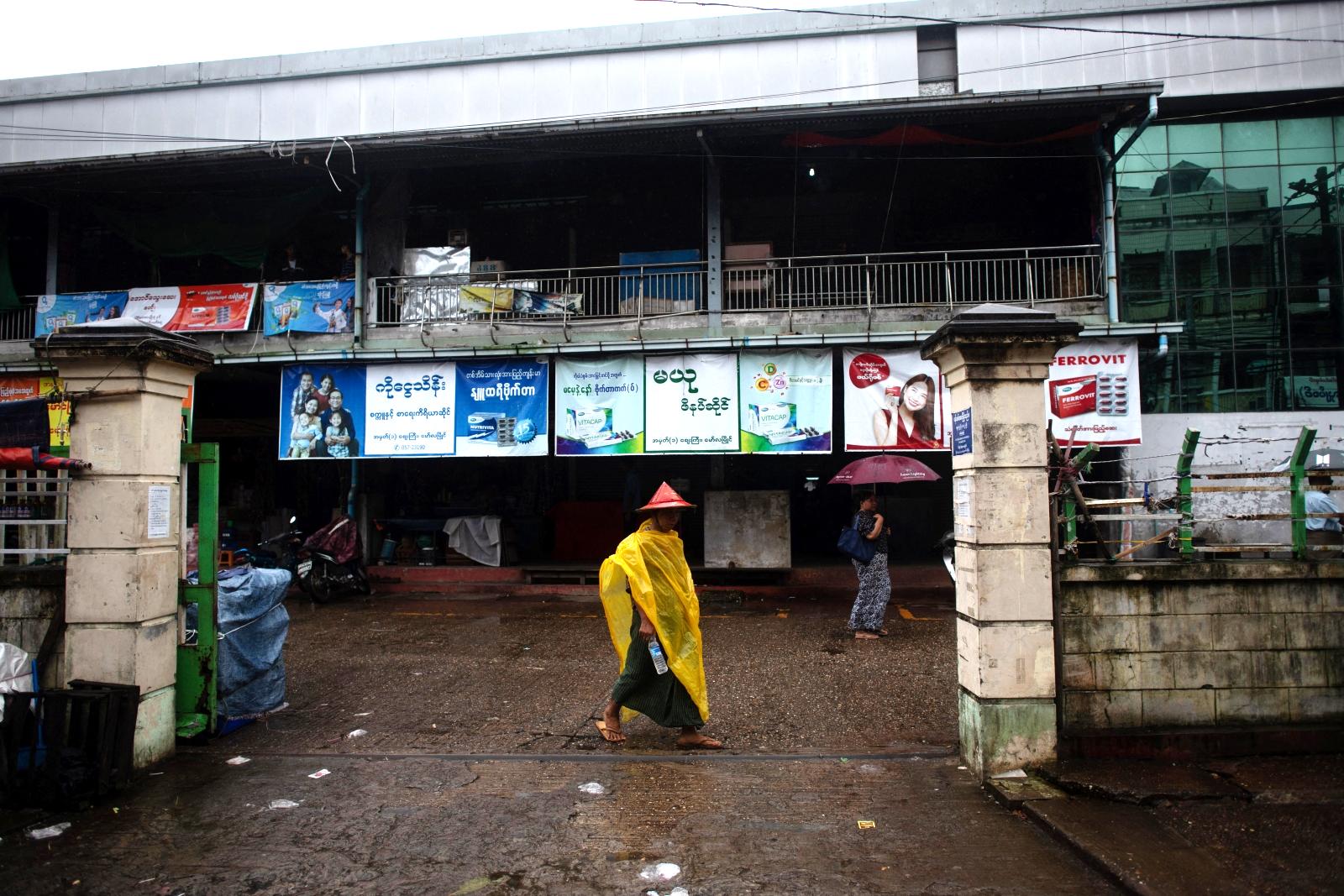Fresh off a one-year ban on logging, Myanmar faces an uphill battle enforcing a new chainsaw registration law.
By ANN WANG & GENEVIEVE BELMAKER | MONGABAY
ALAUNGDAW KATHAPA NATIONAL PARK, Sagaing Region — Ko Pyar Aung still remembers the first time he saw a chainsaw. It was a German-made number being used by one of the logging companies operating in the forest around his remote village in 2013.
“It was so powerful and fast!” recalls 50 year-old Pyar Aung, who lives in the tiny village of Mahu. It wasn’t until August 2016 that he got one himself, and today he owns three. Each cost him around US$124, though cheaper versions can be purchased in urban centres for about seven times less.
In spite of the law, he said he was never asked to show paperwork to buy the chainsaws, nor were any of his fellow villagers.

A villager from Mahu poses with his chainsaw in front of one other source of meagre local income: a mat made of dry bamboo. (Ann Wang | Mongabay)
Support more independent journalism like this. Sign up to be a Frontier member.
The claim is surprising given the fact that logging is practically a cottage industry in his community. Among 37 households they own 70 chainsaws. On a recent visit there, they also said they weren’t aware of the regulation implemented in 2016 that requires them to register their chainsaws with Myanmar’s Forestry Department.
Remote locales like this are at the heart of a struggling government campaign to turn the tide on illegal chainsaw use and logging.
Mahu is a stark case in point of difficulties the Burmese government faces in educating disconnected rural populations about chainsaw ownership and use. The village is an isolated island of homes deep in the Patolon Forest Reserve, part of Alaungdaw Kathapa National Park in Sagaing Region. At 1,605 square kilometres, it is Myanmar’s largest national park.
Despite almost non-existent knowledge of safety equipment, training, and protocols, chainsaws are gaining in popularity as the logging tool of choice in Myanmar’s rich forests. The country is the largest supplier of natural teak (Tectona grandis) in the world.
Forestry officials say they began to see an uptick in imported chainsaws between 2013 and 2014. That increase, with numbers that are very difficult to track and verify, is likely in the hundreds to thousands per year.
That’s bad news for Myanmar’s forests. A chainsaw can cut down a tree four times faster than the more traditional methods of an axe or a handsaw.
The UN’s Food and Agriculture Organization (FAO), which tracks forest cover globally, notes that between 1990 and 2015, the country lost nearly 15 million hectares of forest and other wooded land. There’s no official data yet on whether a national logging ban in place from mid-2016 to April 2017 has had an impact on forest loss.
The geography of locales like Mahu — incredibly remote with limited options for income — contributes to illegal logging. It is completely cut off from the outside world for the 4-month rainy season due to bad roads. The national education system only arrived in the village five years ago, and there is still no electricity nor cell signal. Villagers are motivated by basic economics to own chainsaws for logging to expedite their work.
There’s also a demand.
Brokers from nearby villages started to show up in Mahu in 2016 in search of wood for sale, around the time that the Burmese government instituted regulations for buying and owning a chainsaw.
Pyar Aung says that he can make about $95 per ton of logs. He typically collects 1.5 to 2 tons of wood per week to sell. If the rest of the village logs at a similar pace, they can cut down about 46 tons of wood every week, or over 180 tons per month.
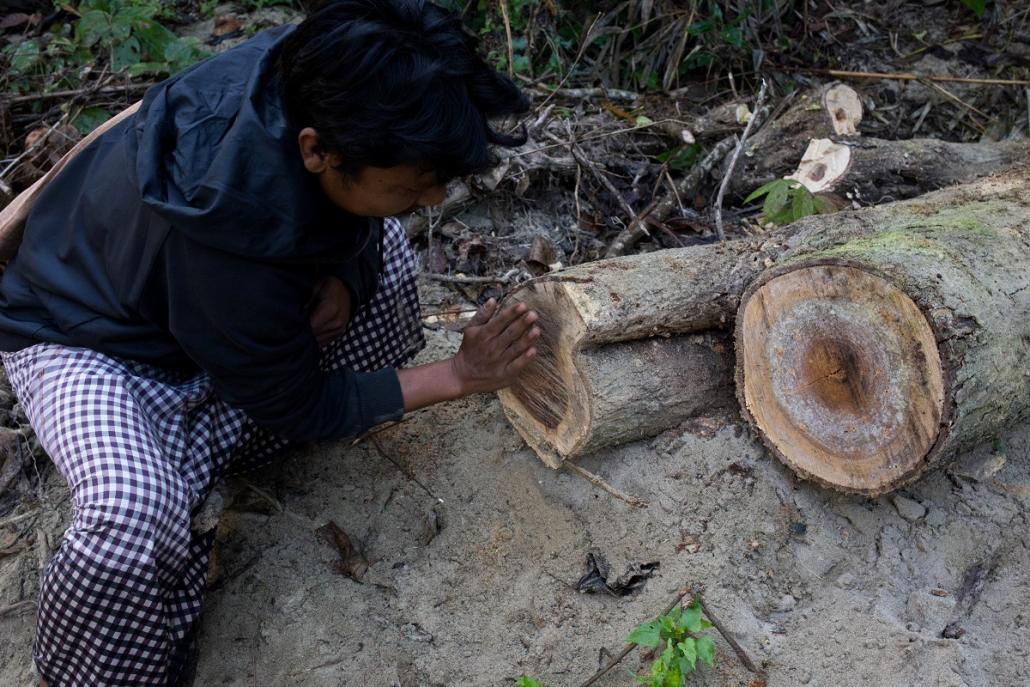
Freshly cut trees, illegally logged, wait on the riverside wait to be transported from the forest to Mahu for sale. (Ann Wang | Frontier)
If they sell what they log at the rate Pyar Aung notes, the village can make at least $17,500 a month. A conservative estimate of annual village income from illegal logging — minus the rainy season — is about $140,000 annually.
For generations, villagers here have eked out an existence on meagre profit from rice farming and other activities like selling handmade bamboo mats. Logging represents a chance to diversify and amplify income streams.
“If we only grow rice, it’s not enough to make a living and that’s why we started cutting trees, but we mostly only log teak,” Pyar Aung said. Teak is one of the most valuable tropical hardwood species in the world. “The demand is so high.”
Regulations and enforcement
Villagers in Mahu might claim ignorance about their illegal chainsaws and logging activity, but their actions suggest otherwise. On a recent day in February, everyone stopped logging, disassembled their chainsaws, and hid the parts deep in the forest upon word of an impending Forestry Department inspection.
Kyaw Minn Htut, founder of Thuriya Sandra Environmental Watch Group, has kept track of Mahu’s chainsaws, which he confirms aren’t registered and were not purchased legally. He has a complex relationship with the villagers.
“It was me who reported this village to the forestry department,” Kyaw Minn Htut said while sitting with residents at their monastery, which also functions as a community hall. “But I asked the forestry department officers to forgive them, because they have no money to be fined and if you take away their chainsaw, they will have no way of surviving.”
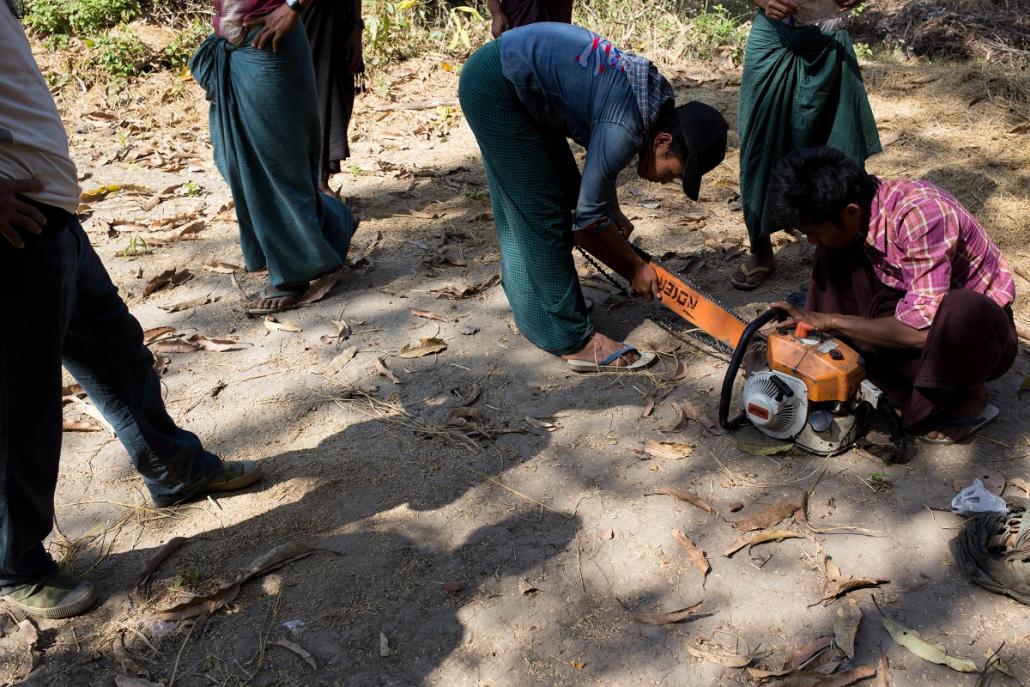
Altered to an inspection by the Forestry Department, villagers from Mahu take a chainsaw apart to hide parts in different locations in the forest. (Ann Wang | Mongabay)
Kyaw Minn Htut is a native of Sagaing Region in his early 40s, and has been doing conservation work since 2003. He is incredibly persistent when it comes to finding and reporting illegal logging. He once spent 10 days in the forest counting unmarked stumps in an area that had been logged and found that the company (whose name he didn’t disclose) had logged 572 extra trees.
“Four [Myanma Timber Enterprise] officers and three [Forestry Department] officers were fired because of my report,” he claims. Kyaw Minn Htut’s philosophy is that deforestation is not caused by individual loggers, but by logging companies approved by the MTE, which regulates the industry domestically.
“Chainsaws are not the problem, the root of the problem is the policy and the law,” Kyaw Minn Htut said. “The current one is set up for organizations that are involved in mass production, but not for the people.”
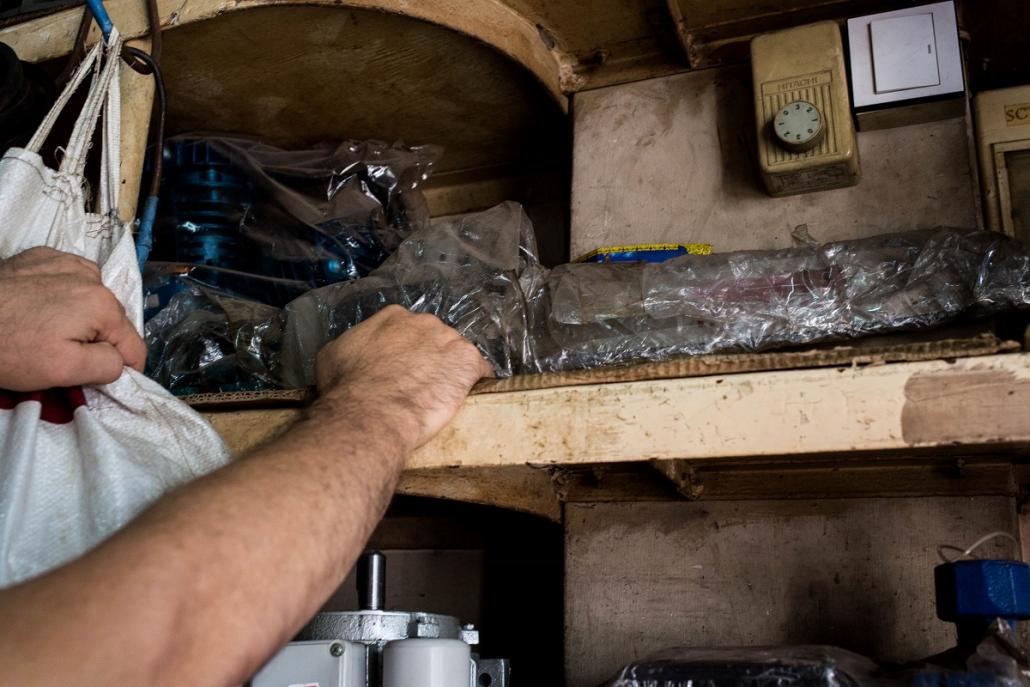
A vendor shows a chainsaw hidden behind other commercial products in a hardware shop in Mandalay. (Ann Wang | Mongabay)
When it comes to the activity in Mahu, he wants to help them to legitimately earn income from logging. With his assistance, the villagers have applied to manage the forest surrounding their village, but have not heard back from the forestry department. It’s unlikely they ever will.
It’s also just as unlikely that they will stop cutting down trees.
“The villagers here at Mahu only cut what they need to survive, they don’t do it to get rich,” Kyaw Minn Htut said. “Besides what will the villagers feel, if the people not related to this area come and harvest all the valuable wood, but they themselves can’t even do that?”
In Mandalay, the nearest urban center for the timber market and commercial goods, people are a bit more savvy about the rules for selling and owning a chainsaw.
Along Mandalay’s so-called “iron street” of machinery and tool shops, out of a randomly selected seven shops along a 40-block stretch, only one displayed chainsaws. Others wouldn’t even discuss a sale without proper paperwork. Fears of plainclothes police officers pretending to be customers are top of mind.
Many other shops take a more subdued approach. Some put the chainsaw blades in the corner, but the rest of the equipment stays hidden in back storage rooms and are only presented on request.
“There is a crackdown on chainsaws,” said Ko Ko Win, who manages one such machinery shop. “If you want to sell chainsaws, you need a license, if you want to buy a chainsaw, you also need a license from the forestry department.”
Win adds that obtaining a license to buy a chainsaw involves answering a list of questions such as reasons for the purchase, which trees will be cut down, and the locations where the tool will be used.
“It’s a very complicated procedure, I don’t understand the reason behind all this madness,” he said. “But I guess it’s the new government, and it comes with new rules.”
chainsaw-mongabay6.jpg
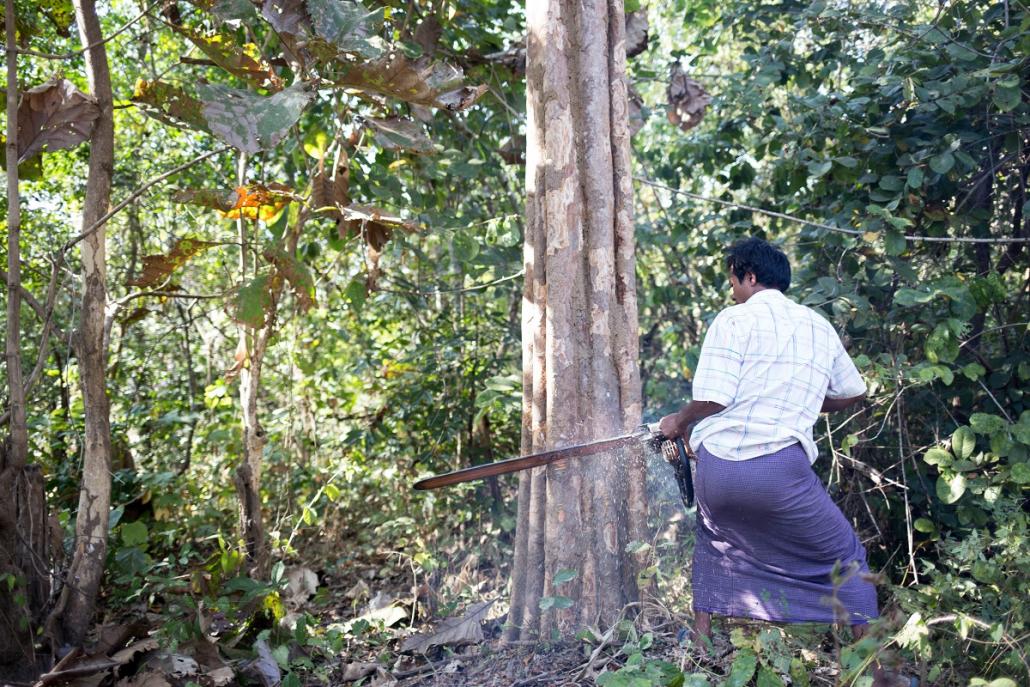
A villager from Mahu cuts down a tree using a midsize chainsaw. A chainsaw can cut down a tree four times faster than an axe and handsaw. (Ann Wang | Mongabay)
In June 2016 Myanmar’s Forestry Department amended its forestry laws to include a policy on chainsaw registration: Whoever uses a chainsaw without permission can be sued, face up to two years in prison, and a fine of up to $15.
They also created a committee with police officers, local and regional forestry department officers, and township administrators to enforce chainsaw rules and regulations. That includes monthly reports from forestry departments in each township, district, division and state to headquarters in Nay Pyi Taw.
Combating the myriad aspects of illegal logging in Myanmar is already a huge job for authorities. Just as the national ban lifted in mid-April, officials announced that in the past year they seized 55,000 tons of illegal timber and 2,600 vehicles and pieces of machinery. Arrests of timber smugglers included 11 foreigners and 8,310 Burmese nationals.
Import headaches
Myanmar is still in the early stages of regulating chainsaws, especially when it comes to import rules.
Officer Phyo Zin Mon Naing is assistant director of Myanmar’s Forestry Department at Nay Pyi Taw and oversees chainsaw registration. He said in an interview that he’s been working on issues regarding chainsaw registration since 2013, but prior to that there were simply no laws or regulations for chainsaws. In 2014, the government started to ask chainsaw users to register equipment, but the system was inefficient and difficult to enforce.
The current procedure, which includes import laws, was put into place after discussion with various departments and the central government.
The complex procedure requires importers to submit an inquiry for a permit to import chainsaws and present their import license and company registration to the Ministry of Commerce. The Ministry of Commerce then submits it to the forestry department for a recommendation letter.
In order to issue a recommendation letter, the forestry department has to first check the chainsaw type, country of origin, import method, the number of chainsaws in the current stock, a list of chainsaw distributors by the company and other detailed information. The importer isn’t technically allowed to sell their chainsaws if they don’t agree to monthly reports on their distribution and stock.
chainsaw-mongabay7.jpg
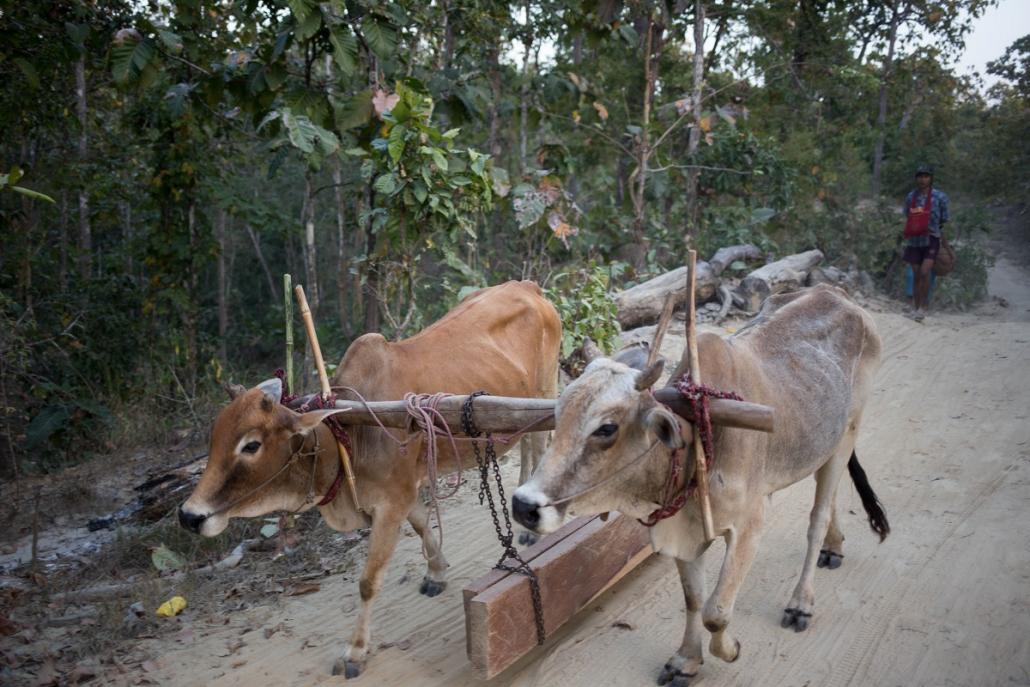
Transporting logs with cows that are usually for farming near Mahu. The porter can usually earn almost $4 per pair haul with a pair of cows. (Ann Wang | Mongabay)
Phyo Zin Mon Naing believes that this system, which targets importers, distributors, and users of chainsaws, is feasible. For example, they once received an application from a machinery shop that wanted to import 20,000 chainsaws. The request was rejected.
“Currently, there are a total of 1,281 legal chainsaws in the country,” Phyo Zin Mon Naing said from the most recently available chart in January 2017. “Sagaing has the most registered chainsaw at 423 units, the second is Mon State with 178 units.”
The numbers clearly aren’t exact, though. For example, the number of known chainsaws in Sagaing Region alone would be 16 percent higher if the units in Mahu village were registered.
Yet despite known pockets of lawlessness like Mahu, Phyo Zin Mon Naing is confident.
“Now we have control over chainsaws in this country,” he said, adding that between 2014 to the end of 2016, they seized a total of 746 illegal chainsaws. Most of those come from individual owners and are handed over to the MTE.
Problems with enforcement
A major problem with monitoring illegal chainsaws is lack of control in insurgency areas, especially Kachin State. Kachin shares a long border with China and is partly controlled by Kachin Independence organization. They have an estimated 8,000 troops and are believed to be involved in illegal logging.
“We believe they have a large logging problem, but we don’t have details,” Phyo Zin Mon Naing said, adding that they have no communication regarding chainsaw registry with members of KIO. “But we work with the Myanmar military to seize illegal timber in those areas.”
They face myriad challenges, some of which could be life and death.
“This work is difficult and very dangerous, officers at the forestry department don’t have guns, we have no security, how do we protect ourselves?” said Phyo Zin Mon Naing. “We just have our pen.”
In fact, Phyo Zin Mon Naing doesn’t think there is a clear connection between seized timber and registered chainsaws, especially since the registry is so new. The forestry department is also still in the process of getting its staff and other government agencies up to speed on the registry’s use.
chainsaw-mongabay8.jpg
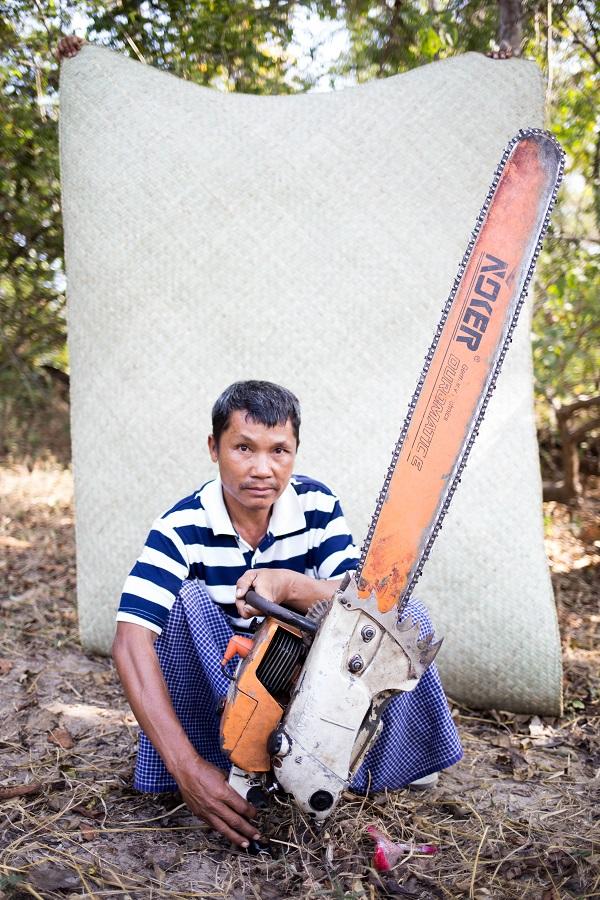
A villager from Mahu poses with his chainsaw in front of one other source of meagre local income: a mat made of dry bamboo. (Ann Wang | Mongabay)
If it proves effective, it could have an impact.
“If we control chainsaws, it will reduce illegal logging in the future,” Phyo Zin Mon Naing said. He added that one way they are doing this is through outreach programs, which include group information sessions on how to register chainsaws and the impact to the environment from illegal logging. In January 2017, he said they held 286 chainsaw registry outreach sessions across the country.
Despite complaints over the complicated procedure to obtain a chainsaw, Phyo Zin Mon Naing sees the approach as standard.
“If you import a car from a foreign country you have to submit paperwork, so importing chainsaws should be treated the same way,” he said. He added that he thinks the forest coverage rate is directly related to number of chainsaws. “There are so few officers at the forestry department but so many loggers in Myanmar, how do we control the situation?” he asked. “We must do it, we must register the chainsaws.”
A hopeful future, at a cost
In Mahu, logging is slowly transforming the lives of the villagers, although not everyone can yet afford to purchase a chainsaw. Khin Maung Htwe is 32 years old, tan and lean from years of rice farming before he turned to working as a timber porter.
“I don’t know how to operate a chainsaw, and I can’t afford one yet, but I’m happy they are cutting wood so I can make some income by transporting the timber out of our village,” Khin Maung Htwe said.
The 4-hour round trip by foot to the nearest village involves tying the timber to his two cows and a two-day rest after each trip. He makes a mere $4 each time.
Thar Kyi is a 32-year-old father of four, and is recognized as a chainsaw expert by other villagers, who joke that he cuts the straightest line with chainsaws. Like Khin Maung Htwe, Thar Kyi doesn’t own a chainsaw and is hired by chainsaw owners for $4 per day to operate their machinery. He said that part of his motivation is based on family obligations.
“I have to pay $5 for my kids [per child] to go to school per month,” Thar Kyi said. Though primary education is free in Myanmar, teachers often ask for extra money in rural areas to offset the cost of uniforms and books.
Even though activist Kyaw Minn Htut is devoted to conservation and to preventing illegal logging, he is sympathetic to the villagers.
“I will never ask them to stop logging, because I have no other money-making options to offer them yet,” Kyaw Minn Htut said. “Before they used to focus more on cultivating rice, now they spend more time on logging and they have to buy rice to eat during the rainy season.”
He doesn’t believe that stricter enforcement of chainsaw regulations will stop the loggers.
“They will just go back to using axes and handsaws, the illegal logging will continue and so will the bribery to related governmental officials,” he said.
This article was first published by Mongabay and has been republished here with permission. TOP PHOTO: A villager from Mahu cuts down a tree using a midsize chainsaw. A chainsaw can cut down a tree four times faster than an axe and handsaw. (Ann Wang | Mongabay)


